


































































































8 Headline News
SWR nationalisedasnew GBR logo is launched;Train manufacturers seek clarityonfutureorders
47 Steam Eddystone and Princess Elizabeth close in on areturn.
53 Industrial steam Mid-Suffolk Railway ’s EasterGala success.
54 Heritage Carriages &Wagons New home formilk tank and makeoverfor acid tank
56 Narrow Gauge
VoRdonates Conqueror fordisplayatW&LLR
62 Miniature Nor th TynesideRailway launches miniatureventure
63 Heritage Trams
£150,000 target forCrich ‘Access Tram’project
64 Classic Traction
1990s look forWensleydale Class 47/7.
66 Railtours
Tornado returns to main linerailtours
69 Freight Nor thampton’s new 35-acrerailfreight terminal
70 Metro
Class 555s return to ser viceonTyne& Wear Metro.
72 Network Nine -day Cross-Cityclosurewill allowfor HS2 works
74 Traction &Stock,Wagons
Hydrogen hybrid plan forClass18shunter
77 Stock Update
What is new,withdrawn, named or reliveried
81 Operations News
Notable movesfromaround the network
87 Irish Passenger numbers increase on rail routes in Ireland.
88 World
Crowds turn out forDresden’s annual steammeeting
23 Subscriptions Offer
Agreat deal and have your magazine delivered,too
41 Readers’Platform &Where is it?
Dai of shame; Closed access operations
42 Meetings
Local events and talks around the countr y.
43 Years Ago
Newsitems in TheRM issues 100, 50 and 20 years ago
44 Panorama
Aselection of the bestinrailway photography.
91 Reviews
Ourthoughts on some of the most recent books.
98 Crossword&NextMonth
Tr yyour hand at ourpopular prizepuzzle
16 Abrave newworld
Part 6ofour Railway 200 stor ycovers Nationalisation in1948 which, as Mike Jones FRSA FCILTdescribes, failed to deliver on expectations,but washampered by postwarmaterial shortages.
24 Practice&Per formance
John HeatonFCILTwas aboardasdouble -chimney ‘Jubilee’ Bahamas returned to Carlisle,with unassisted climbsofShap and Ais Gill as par tofthe itinerar y.
30 Thespark thatlit the flame
In this Railway 200 year,weasked foryourmemories of howrail enthusiasm began foryou
36 Engineer and enthusiast
Howard Johnston FCILTpaystributetothe senior British Rail figure who opened thedoor to US-built traction, helped save thepioneer Class 20 and 40, and developed safetystandards formain line steam.
96 TheLong View:June
Photographs from TheRailway Magazine’s archive, with this month’sthemebeing ‘Tunnels’.











PUBLISHING
Produc tion editor: SarahWilkinson
Designer: TimPipes
Editorial assistant: Jane Skayman
Publisher: TimHar tley
Sales and distribution manager: Carl Smith
Head of Marketing: CharlottePark
Commercial direc tor: Nigel Hole
Publishing direc tor: Dan Savage
Published by: KelseyMedia Ltd, Media Centre,Mor tonWay,Horncastle,LincsLN9 6JR Tel: 01507 529529 Fax: 01507 371066
Email: railway@mor tons.co.uk
ADVERTISING
Group adver tising manager: SueKeily
Advertising: Andy Bruce abruce@mor tons.co.uk Tel: 01507 529455
By post: TheRailway Magazine adver tising, Kelsey Media, Media Centre,Mor tonWay, Horncastle,Lincs LN9 6JR
SUBSCRIP TIO NS
Full subscription rates(but see page23for offer): (12 months,12issues,including post and packing) £66 forthe UK.Expor trates arealso available,see page 23 for moredetails.UKsubscriptions arezero-ratedfor the purposes of Value Added Tax.
Enquiries: subscriptions@mor tons.co.uk
CUSTOMER SERVICES
General Queries &Back Issues 01507 529529
Monday-Friday: 8.30am-5pm Answerphone 24hr help@classicmagazines.co.uk www.classicmagazines.co.uk
Archiveenquiries
Jane Skayman 01507529423 jskayman@mor tons.co.uk
PRINT AND DISTRIBUTION
Printed by: William Gibbons &Sons Ltd.
Magazine &Catalogue Printer, 26 Planetar yRoad, Willenhall,West Midlands,WV13 3XB
Distribution by: Seymour Distribution Ltd, 2Poultr yAvenue,London,EC1A 9PU Enquiries Line: 0207 429 4000
Accepted photographs and ar ticles will be paid for upon publication. Items we cannot use will be returned if accompanied by astampedaddressed envelope,and recorded deliver ymust clearly state so and enclose sufficientpostage.Incommon with prac ticeonother rail periodicals,all material is sent or returned at the contributor ’s ownriskand neither TheRailway Magazine,the editor,the staffnor Kelsey Media Ltdcan be held responsible for loss or damage, howsoever caused.The opinions expressed in TheRM arenot necessarily those of the editor or staff.This periodical mustnot,without the written consentof the publisher first being given, be lent, sold,hired out or other wisedisposed of in amutilatedcondition or,in anyunauthorised coverbyway of trade or annexedto or as par tofany publication or adver tising,literary or pic torial matter whatsoever
HOWTOSUBMIT PHOTOGRAPHS
Please email high-resolution digital images in jpg/jpeg or tiff formattormpix@mor tons.co.uk Send only unprocessed and ‘straightfromthe camera’ images,and include basic details of ‘what, whereand when’plus the photographer ’s name in theimage’s file name.Ifpossible,embed afull description in the image’s ‘File Info’sec tion.
CDs or memor ysticks can also be accepted by post
This issue waspublished on June 4, 2025. Thenextissue will be on sale on July 2, 2025. ©Kelsey Media ISSN 0033-8923
THROUGH well thoughtout and skilfulplanning(andinnoway down to sheercoincidence, ahem), Part 6ofour series of articles covering thelast200 yearsofrailway histor ylooks at theearly yearsof postwar Nationalisationinthe same monththatthe present Government re-nationalisedSouth WesternRailway andlauncheda newlogofor thefuture GreatBritish Railways
Nationalisationin1948 wasabout rebuilding therailwaysafter adecadeof damage andunderinvestment caused by theSecondWorld War. It waslaunched with much hope forthe future,but the realitywas amixed bagofsuccesses and failures.While fundingwas allocated, planstoimprove theinfrastructureand rollingstock were hampered by alack of suitable materials, especially steel, meaningthatmanyschemes went unfinished or were abandonedaltogether. Notonlythat, buttraditional railway marketswerechanging, as private ownershipofcarsreduced thenumberof passengers usingthe trains,while road haulagewas taking overfromwagon load rail traffic.
Modernisationinthe form of aswitch to more widespread useofdieseland electric traction,which hadbeenbegun by the‘BigFour’ before thewar,was put















on hold forthe best part of twodecades Instead, newsteam locoswerebuilt that kept miners in employment forthe coal, butalsoprolonged old-fashioned and inefficient methodsofworking Fast forwardto2025, andonceagain nationalisationofsorts promisesa bright future afteralmost30years of privateoperators runningtrains, in which, accordingtothe critics, money hasbeen‘lost’fromthe industry to pay shareholders’dividends.But this time will be no BritishRail2.0, as nationalisation underGreat BritishRailwayswillbe limitedtothe rail infrastructure plus most passengeroperationsinEngland–services in Scotland andWales beingrun by theirdevolvedGovernments,while freightwillcontinuetobeinthe private sector,aswillthe rollingstock leasing companies.
So what difference it canactuallymake this time remainstobeseen. Perhaps, like thefirst time round, therewill be some things that work,somethingsthatdo not, butanawful lotin betweenthatdoesnot really change at all.






















































1: Thefour-daySpring Diesel Gala at theSevern ValleyRailway on May15-18 featured no less than 10 visiting main line locomotives,inaddition to those from the extensivehomefleet.The visitors were Nos.37706 (West Coast Railways), 43468+43480 (RailAdventure), 56094 and 56113 (Colas), 57003 Inter CityRailway Society (LSL), 58023 (EdStevenson), 66509 Freightliner Retirement Association (named at the event, Freightliner), 69014 EMD Longport (GBRf ), and 70020 (Freightliner).Railfreight grey-liveried No.57003 is seen arriving at ArleyonMay 16, with the13.40 Hampton Loade to Kidderminster BRAD JOYCE
2: Showing off its Kestrel-likeretro liver y, GBRf ’s No.69014 pulls into ArleyonMay 17 with the 16.15 Hampton Loade to Kidderminster STE VE WIDDOWSON



3: Preser ved‘Bone’No. 58023 first worked at last autumn’s SVR gala and returned forthe spring one,seen passing the Rifle Range at BewdleyonMay 15 with the 12.30 Kidderminster to Hampton Loade BR AD JOYCE
4: Freightliner ’s No.70020 wasa popular choice, the orange and black-liveried heavy freightloco pictured leaving BewdleyonMay 16 with the 15.20 Kidderminster to Highley. ED WEAVER
5: Home fleet locos Nos.50035 ArkRoyal,D1062 Western Courier and D1048 Western Lady do a passable impression of Plymouth in the mid-1970s when captured at Kidderminster on May18. STE VE WIDDOWSON

Theongoing transition from franchised operators to GreatBritish Railwayshas led to adearthofordersfor new fleets.
By ‘IndustryUpdate’
NATIONALISATION of the former franchised operators running under National Rail Contractssincethe Covid pandemic,has meantthatplans forbuilding new rolling stock have dried up from this group of operators.Orders forfurther new trains arethereforeunlikely to resume until GreatBritish Railwaysisestablished next year, although thereare rumblings thatthis maynow be pushed back to 2027.
Privatisation in the mid-1990s sawmanymoreorganisations takeoverresponsibility for ordering new rolling stock than waspreviously the case in the British Rail era–such as the devolved governments in Scotland and Wales and an increasing number of regional mayors across England Franchised and open access operators also organised the procurementofvehicles to meet their owntimetable needs.For example,Virgin Trains replaced the West Coast and CrossCountryfleets in their entirety, with Class 390 ‘Pendolinos’and Class 220/221 ‘Voyagers’taking over from loco-hauled stock;while the successful bid by Abellio in 2012 forthe GreaterAnglia franchise wasalso based on complete fleet replacement; and Stagecoach and others replaced the Mk.1-based ‘slam-door’ EMUsonthe third-rail network across Southern England
Over time,the Department forTransporthas clawed back the free hand given to the franchised operators by deciding thatnew trains forenhanced Thameslink services and the replacement HSTswouldbeGovernmentsponsored contracts. These procurementdecisions were viewed as unsatisfactory by the National Audit Office, who asked whythe DfThad adopted this policyasithad no expertise in specifying rolling stock specification, leading to delays and inflatedcosts TheGreat Western franchise holderFirstGroup had initiated its ownplan to replaceHSTs,
but wasfirmly told this was to be aDfT responsibility. This contrasted with earlier policy wheretherehad been no intervention in the West Coast InterCityfleet replaced by Virgin.
One of the reasons for the changewas that the DfT believed it could access cheaper funding than using arolling stock leasing company(Rosco). What wasignored,however, wasthatthe Roscos have developed skills and experience in buying trains and associated maintenancepackagesthatthe Governmentdid not have. Wherethe Governmentdid succeed wasinpersuading Hitachi to assemble the InterCity Express Programme vehicles at an assembly plantatNewton Aycliffe, rather than importing fully finished trains.However, the oppositeoccurred with the Thameslinkorder,where Siemens built all 1140 vehicles at its existing plantatKrefeld (Germany), which leftDerby Works disappointedas the order had been expectedtogothere.
It wasadecision based on financingcosts,asSiemens was able to attractcheaper finance than Bombardier (nowAlstom), but therewas noinput about the potential loss of economic benefit to the UK if closureof the Derby planthad resulted.
Delays to the HS2 projectand cutbacks to the routes have hadan impactonboth Hitachi and Alstom, as Hitachi will build the vehicle bodies at NewtonAycliffe and Alstom Derbythe bogies and associatedrunning gear
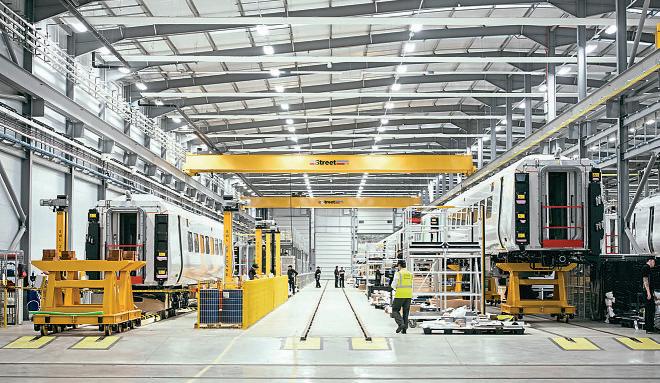
arenow lifeexpired,the often noted 1980s-built ‘Sprinter’family DMUscontinue to operatesatisfactorily if they are well maintained and refreshed internally.Asanexample, a journey using aClass 159 unit on Waterloo-Exeter services is alot morecomfortable than some of the morerecentvehicle types in use
The‘Sprinter’ classesare not likethe now-withdrawn ‘Pacers’, which fulfilleda need to replacefirst generation DMUs at acost thatwas acceptable, when compared to proposals forusing buses instead on
sets removedfromuse with TransPennine Express. With passenger numbers nowaround pre-Covid levels again, the slack is being taken with the return of the Class 379 sets with GreatNorthern outer suburban services and the Class 175 units aretobereturned to servicewith GreatWestern Railway to compensate forthe withdrawal of the short-formed ‘Castle’HST sets on West of England diagrams
Guessing the future
“Wherethe Governmentdid succeed wasinpersuading Hitachi to assemble the InterCityExpress Programme vehicles at an assembly plantatNewtonAycliffe”
Fortunately,the gap in output at Derbyhas been partially filled by an order from Transportfor London for10additional ninecar ‘Aventra’Class 345s forthe Elizabeth Line,plus acontract to refurbish the ‘Voyager’ fleet.Meanwhile, Hitachi has managed to attractordersfrom FirstGroup and Arrivafor open access operations.
‘Sprinters’going strong
Although thereis constantinput from stakeholders representing the manufacturing and supply industrythatmanyrail vehicles
manysecondaryand rural services.The journeyexperience wascertainlypoor,and crashworthiness wasfar below currentstandards,sotheir replacementeventually became essential
Thelower levels of demand that followedthe Covid pandemic also removedany immediate urgencytoreplace older fleets.Indeed, some fairly modern vehicles were taken out of use,including Class 379 EMUsdisplaced from Stansted Airportservices,Class 175 DMUsthatare not partoffuture Transportfor Wales’s needs, and locomotive-hauled Mk.5
When new orders eventually come,the type of rolling stock built will have to be suitable fornetwork use over aperiod of up to 30 years,during which it is the intention to deliver ‘net zero’objectives.But there is continued uncertainty about the extent of further electrification, meaning purely electric trainswill have to be supportedby bi-mode and tri-mode vehicles from achoiceofdiesel, hydrogen, and batterypower Bi-mode rolling stock that makes use of the electrified network whereavailable has eliminatedthe use of diesel poweroverlong stretches of route, such as working between London and Hull,Swansea and North Wales.But services operated by CrossCountry continue to use the ‘Voyager’ fleet forsignificantmileage ‘under the wires.’Thecurrent refurbishmentofthis fleet indicatesthatthereisno immediate plan to introduce anybi-mode capability. Whereelectrification is
unlikely to be justified,future rolling stock specs have included the use of hydrogen and batterypower.However,it is noticeable thatthe hydrogen option has become less favoured recently,one reason being thatbus fleets introduced using this technology have suffered from poor reliability and ashortage of fuel supplies
TheRailwayIndustry Association has promoted batterypower as away to decarbonise rail services in the future. But this will likely require morewidespread electrification because of the limited range thatcan be operated using batteries.
Among the electrification projects suggested is thatto provide wiring from Shrewsbury to Hereford, Newcastle to Hexham, and Westburyto Newton Abbot.Itishardtosee thatisolatedsections of wiring based on aneed forcharging batteries is arobust solution in the eventofservicedisruption.
Forfreight, much diesel haulage could be reduced by modest infill electrification, such as to reach the terminals at Felixstoweand London Gateway, with shortsections of bi-mode working to inland distribution terminals
Another proposal forlengthy non-electrified routes is that fast charging equipmentcould be installed at intermediate stations on lines such as the Cambrian and Cumbrian Coasts and from Settle to Carlisle,but it is hardtosee thatprolonged station dwell times would be acceptable to allowcharging to takeplace.
Waterloo-based operator becomes the fifthformer franchisetocome under Dftcontrol.
MAY25saw South Western Railway become the fifth former franchise to be taken under Governmentcontrol,and the first by the currentLabour Government, as it works towards establishinganew GreatBritish Railwaysorganisation.
TheGovernment described it as a“new dawn forrail”, with TransportSecretaryHeidi Alexander adding thatfares would be unlikely to fall,with afocus instead on improving services and infrastructure.
Afterreplacing former privateoperator FirstGroup and MTRCorporation, the first official servicetorun by the renationlised SWR wasthe 05.36 from Woking to Surbiton,
the onward journeytoWaterloo beingreplaced by abus service due to engineering work SWR is nowthe responsibility of the Departmentfor Transport Operator,which already runs LNER, Northern,TransPennine Express and Southeastern. Further former franchiseswill be added to the list as their National Rail Contractsend, with c2c expectedtobenexton July 20, and Greater Anglia on October 12 Operations and Network Rail’s infrastructureresponsibilities are to be combined into asingle GreatBritish Railwaysentity, but thatfirst requires legislation to be passed in Parliamentthis autumn. If it does,GBR should

be established sometime in 2026 or 2027 to manage tracks across Britain and most passenger train operations in England.Until then, the DfTwill remain in charge of nationalised operators Thereturn of SWR to
Governmentcontrol was accompanied by the launch of anew GBR logo.This features asection of Union Flag,the National Rail/former British Rail ‘double arrows’ logo, the words GreatBritish Railwaysand –for now–the rider ‘coming soon’.
By Graeme Pickering
LONDON Northwestern Railway is making final preparations for entryintoserviceofits Class 730/2 ‘Aventra’EMUs.
LNR plans to begin using the Alstom-built sets on workings at the southern end of the West Coast Main Line on June 9. They will be gradually introduced to diagrams currently operated by Class 350s
Speaking on May16while unit No.730220 wasondisplay to the media at Northampton station, John Doughty, engineering directorfor West Midlands Trains (which operates services under the LNR and West Midlands Railway brands) said he expectedthe first Class 730/2-operated servicetobea Euston-bound one
“Initially we’rerolling them outinthe West Coast South area,” he explained,“on atemporary basis on Liverpool-Birmingham
RIG HT: Although experiencegained with the West Midlands Railway Class 730/0s has been beneficial to the processofironing out potential issues with the Class 730/2s,the in- cab noise initially due to their higher topspeed of 110mph wasaproblem which had not been experienced before, and this has been resolved with the installation of per forated panels GR AEME PICKERING
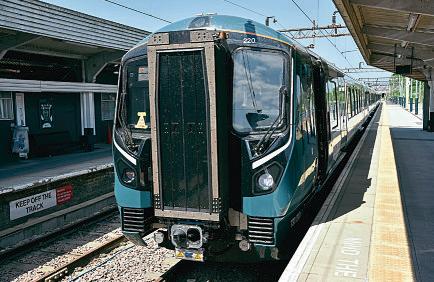
–that’salittle bit lateron into the summer –and then on the CrewetoLondon services later on into the year.”
Built by Alstom at its works in Derby, 33 of the 36 Class 730/2sordered have so farbeen accepted by LNR. Thefive-car sets areconfigured forlonger journeysthan the 48-strong, three-car West Midlands Railway Class 730/0 fleetand

have atop speed of 110mph rather than 90mph. Each ‘730/2’ set has 406 seats and they will generally work in pairs.
Introduction plan
Mr Doughty expects thatat least 24 of the Class 730/2s will be in traffic by the beginning of the December 2025 timetable, sufficienttoallowthe handback of the 30 remaining Class 350/2s

End forlongest ser vice
THE final CrossCountr y(XC) ser vicefromAberdeen to Penzance, the longest through-train in Britain, ran on May16. Leaving Aberdeen at 08.20 and arriving in the Cornish terminus at 21.40, the train became knownas an endurancetest foranyone wanting to do the full route by ‘Voyager ’, with XC even offering certificatestothose who completed the journey
Thefinal trip began with five- car No.221128, which wasjoined by No.220002 at Edinburgh as far as Bristol Temple Meads
Athrough ser vicewas introduced by the Great Western Railway in 1921, but has been ended in the name of amoreefficienttimetable, according to XC.A ser vice will still run from Aberdeen to Plymouth and Edinburgh to Penzance, but passengers will nowhavetochange to makethe full journey
St Blazey engineering training centre appeal
LEFT: Class 730/2 No.730220 at Nor thampton on May16, where it wasondisplaytothe media. The‘Aventra’ units aredue to enterser viceonJune 9, and will takeonWest Coast Main Line workings,allowing the handback of LNR’s remaining Class 350/2 sets.Assoftwareupgrades arestill being carried out,not all units within the class are currently compatible with each other.The sign in the cabwindow explains whatversion the unit is currently using. GR AEME PICKERING
leased to LNRtobecompleted by the end of the year.He believes thatwill result in a moreconsistentenvironment forpassengers,asthese trains have not hadthe same level of refurbishmentasthe other Class 350 variants in LNR’s fleet, which aretoremain in use on Birmingham-NorthamptonEuston services
Given the higher operating speed of the Class 730/2s compared to other‘Aventra’ units,their topspeed being 110mph, one of the hurdles to be overcome wasexcessive noise in the cab at speeds above 90mph, which was solved by fitting per forated panels.
Regarding the remaining three Class 730/2s still to be accepted from Alstom, Mr Doughty says thatthe manufacturer is working through issues which are“unit specific”and “fleet specific”,but predicts thatall will be handed over beforethe end of the year
SOCIAL enterprise MPower Cornwall is raising funds to open an engineering training centre at St Blazey depot in Cornwall
Theaim is to teach practical engineering and construction skills from this September and MPower says the focus will be on children and young people from disadvantaged backgrounds Funds have already been raised towardsthe project, including from civil engineering firm BAM, but a crowd-funding schemewill be launched in early June to raise the remaining £75,000. Seew ww.mpowerkernow. org.uk formoreinformation.
THE Depar tmentfor Transpor thas announced the minimum age thatpeople can become train drivers will be loweredfromthe current 20 to 18. Themoveisaimed at recruiting morepeople to the profession and the change could takeplacefrom December 2025. Theaverage traindriver age is currently saidtobe48and rising,with 30% of drivers due to reach retirementage by 2029. Theplan is backed by train driver ’s union ASLEF,with its general secretar yMick Whelan saying: “ASLEF has been campaigning formany years forthe lowering of the age at which drivers can star t training.Atthe moment, young people who want to become train drivers leave school or college at 18 and get other jobs.”
Derby‘drag’tour
THE Branch Line Society
is running aone -way tour from CrewetoDerby Works on July 31, formed of aClass 57 haulinga Class 390 ‘Pendolino’. The ‘Creighton-Ward Explorer ’is apositioning move ahead of the ‘Greatest Gathering’ eventatAlstom’s Litchurch Lane Works,and offers arare oppor tunity to ‘grice’ the rare connection into the factory
Thetrain is expectedto be formed of No.57307 hauling 390119, subjectto availability. Passengers will then be givena guided tour of the eventbeforeitopens to the public the following day, and tickets include aride on theWorks’one mile -long test track
Seew ww.branchline.uk for moreinformation.
TR ANSPORT forWales says thatfromthe start of the new timetable on May18, 70% of its ser vices areformed of ‘new ’trains.This figurewill be fur ther boosted when Class 756 tri-mode trains are introduced to the Coryton and Penar th lines in summer.
Thetimetable change also sawanew platform open at Aberdare, just south of the main station and opposite the SobellLeisureCentre. It is forarrivals only, and passengers travelling from Aberdaretowards Cardiff will continue to use the original Platform 1. Theplatform is accompanied by anew track loop thatwill allowmore trains to run as par tofthe South Wales Metroscheme
NRM unlocked
AN open weekend planned forvenues across York on September 27/28 includes par ts of theNational Railway Museum thatare normally closed to the public
York Unlocked is afree eventgiving access to around 50 buildingsand spaces across the city. Behind the scenes access at the NRM includes its archives,art stores,conser vation studio and inside locomotivecabs
Other venues taking par t include Nestle’s Production Technology Centre,the Old Bonding Warehouse,the Holgate Windmill,the York Medical Society, the Joseph Rowntree Memorial Librar y and the medieval Guildhall wheretowncouncil meetings arestill held.
Seew ww.york-unlocked org.uk formoreinformation.


DB Cargorenamed No.67005 from Queen’s Messenger to King’s Messenger in mid-May,inlinewith the reign of King Charles III. Theloco, picturedatOxfordParkwaywiththe British Pullman on May1,isused to haul the RoyalTrain alongwith classmate No.67006 RoyalSovereign. Thenew platesand cyphersweremadeatthe Procast Foundr yin Cleckheaton, West Yorkshire, wheretheyare picturedbeing worked on in earlyApril. ROGER HAMPSHIRE /JACKBOSKE TT
A‘Balloon’car,alongwith the illuminated Frigate andWesternTrain areexpected to be in use forthe town’s Lightpool Festival
By Graeme Pickering
HERITAGEoperations areexpectedtoreturn to Blackpool’s tramwayfor the Lightpool Festival between October 15 and November 1, and during the rest ofthe town’s Illuminations season.
Blackpool Council has been working with Blackpool Transport on aplan to resume heritage tram tours following their sudden suspension at the beginning ofDecember last year.Atthe time,the companydrewattention to the continuing challenges of running the vehicles alongside
its fleet of Bombardier ‘Flexity 2’ trams,which took over normal timetabled ser vices in 2012 aftermodernisation of the system.
Managing directorJane Cole said (RM, January 2025) thattherewere“complex operational issues”that needed to be addressed before they could return to operation. She added thatthere had been technical difficulties relating to theintroduction of obstacle detection and collision and overspeed prevention systems into use on the network,aswell as some safetyconflicts and logistical problems relating

Afour th platform has been opened at BradfordForster Square station that allowedLNER to run more directtrains from the citytoLondonfromthe May18timetable change. Platform 0has opened on the east side of thestation, raising capacitysuch that the East Coast Operator nowruns sevendirect trainstoKing’s Cross insteadofthe previous two. Open access rival Grand Centralrunsfourdirecttrains to London from Bradford Interchange.No. 801224 is pictured in the newPlatform0 forthe official opening on May19. TOMINGALL
to depot spaceand tram movements
Thecouncil confirmed in Maythatmodifications will be made to “enable heritage trams to runout of the Starr Gate depot”. Home to the ‘Flexity 2’ fleet,which has already been fitted with safetyupgrades, Starr Gate has been used forstabling trams used on heritage tours sincerestrictions were placed on access to their base at RigbyRoad in 2023.
Blackpool Transpor tplans to make a‘Balloon’car and twoilluminatedtrams (the Frigate and the Western Train) available fortours during Lightpool.Ithas been working with the University of Huddersfield on a‘plug and play’ overspeed prevention system forthe heritage fleet
As TheRM went to press,the
companywas unable to say if this would form par tofthe modifications prior to use of the three trams this autumn, or confirm its plans forthe other heritage cars ■ Manchester Transpor t Museum Societyhas announced thatHeaton Park TramwayMuseum at Middleton Road depot will open from 12.00-16.00 on the last Sundayofevery month during the summer,uptoand including September 28. The tramwayitselfremains closed while work to renovate the substation continues,but admission to themuseum is free and displayshavebeen revamped.Visitors can climb aboardHull No.96for alook around and see progress with the ongoing restoration of Manchester No.173.
To celebratethe long ser viceofthe Class 91 and Mk.4 ‘Intercity225’ sets,LNER proclaimed May22as‘225 Day’ and named No.91106 Swallow.The locopropelled the 12.45 Leeds to King’s Cross,onboardwhich wasspecial Intercity 225 merchandiseand memorabilia from over theyearssince they were introduced in 1989. Thenameplate is seen being preparedat Neville Hill depot,Leeds,onMay 19. LNER

















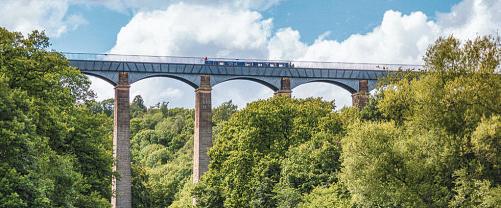







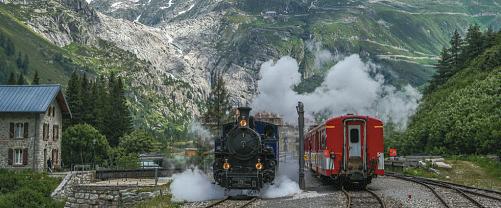










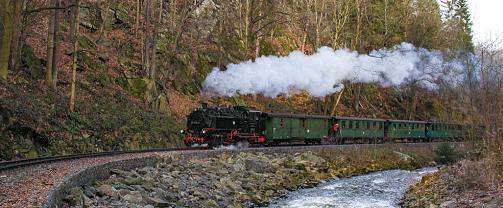






Ongoing to June 22
HOPETOW NDARLI NG TO N ‘Railway Pioneers’, an exhibitionlooking at the engineering innovation thatinspired George Stephenson.
Ongoing to Januar y2026
NRM YO RK
‘Railway Firsts’, acollection of well known and unexpectedstories thathaveshaped the railwaysand our histor y.
June2-earlySeptember
VA RIOUS DATES
Bluebell Railway ‘Education’(forschools) and ‘Celebration’(general public) events covering the past,presentand futureofour railways.
June 27- Oc tober 1
VA RIOUS LO CATIONS
‘ExhibitionTrain’– bookings nowopento visit the Railway 200 trainasittravels to morethan 60 locations around the countr y. Forinformation on howtobook see railway200.co.uk/inspiration
July11- Oc tober 5
HOPETOW NDARLI NG TO N ‘STEAMtothe Future’,reflectingon the histor yofsteam railwaysand howthe rail industr yisgearing up fora second revolution driven by green technologies.
August 1-3
ALSTOM DERBY
‘The Greatest Gathering’Works open days SOLD OUT
REPRESENTATIVE ‘blue plaques’for peopleinthe South East who have contributed to the developmentofthe railwaysare to be unveiled at aspecial eventinLewes Town Hall on August 1.
Rail Fair 200 has been organised by theSoutheastCommunitiesRail Partnershipaspartofthe nationwide Railway 200commemorations
Information forthe 200 plaques has been researchedby SCRP officers working with museums, historygroupsand community organisations.Therewill be 100 plaques summarising historic people and events,and 100 detailing jobs in the rail industry.
Rail Fair 200 will include senior

representatives from train operating companiesonSCRP’s area, as well as Network Rail volunteers.There will
MAY19-25 sawmorethan
130 activities organised as par tofthis year ’s Community Rail Week at Haltwhistle in Nor thumberland.
Theprogramme of national activities aimed to reflectthe

bond between railwaysand the communities they ser ve, and included ‘Try the Train’ trips organised to increase the confidenceofpeople who do not travel regularly by rail
be 40 stalls highlighting the work of the communityrail partnership,its partners and stakeholders
Heritage line anniversar yclean-up
AS partofplans to improvethe environmentduring the Railway 200 celebrations,50volunteers took part in aclean-up on the 18-mile Wensleydale Railway in April.Anunopened bottle of vintage prosecco was one of the moreunusual items discovered,aswell as abandoned chairs,shopping trolleysand electrical goods



ASLEF deal benefits
BARONESS Cavendish asked when the Department of Transport(DfT) will be reporting on the performance of trains,including on running times,cancellations and staff absences,following the pay agreementwith ASLEF.
TransportMinister Lord Hendy replied: “Resolving the long running paydispute has broughtcertainty for passengers as we work to improvethe railways. The OfficeofRail and Road (ORR) publishes quarterly and fourweekly statistics on punctuality, reliabilityand causes of delay forpassenger trains operating on the main line network
“This information shows thatthe moving annual average forcancellations has remained flatat4.1% forthe most recent three rail periods; suggesting thatreliabilityis stabilising following alongterm declining trend over the past decade.This is helping to improverevenue,which is goodnewsfor taxpayers.
“Weare committed to providing transparency
Compiled by Jon Longman
forpassengers around performance, which is why we have made station specific performance information available at morethan 1700 stations across England.”
Cancellation trends
LORD Birtasked whetherthe DfThas assessed cancellations and the reasons forthem compared with other G7 countries.
Lord Hendy said: “No assessmenthas been made on howthe incidenceof train cancellations and the reasons fortrain cancellations compare with the operation of rail services in other G7 countries.
“The Independent Regulators’Group Rail (IRG-Rail) publishes an annual reportwhichincludes European comparisonson infrastructurecharacteristics, punctuality, and traffic data forboth freightand passenger services. This helps to benchmark performance, identify trends,and highlight differences and similarities among the participating countries.However,this report


does not coverinternational comparisons of cancellations.”
Ocean links ahoy VISCOUNT Waverley asked whatconsideration the Departmentfor Business and Trade (DBT) hadgiven to UK involvementinthe proposed African transcontinental railway connecting the Atlantic and Indian Oceans.
DBTMinister Baroness Jones replied: “The project is at an early stage,however the Departmentfor Business andTrade is actively involved in arange of railway projects in Africa. Through its network of staff,DBT supports UK companies gain access to opportunities in the rail,engineering and manufacturing sectors, creating UK jobs and growth.
“Recentexamples include aLetter of Intent signed last year between the Southern African Railway Association and the UK Railway Association, committing to explorepriority rail corridors in Southern Africa, which also includes the Tanzanian, Angolan and DR
Congo railway companies
“Therehavealso been notable commercial successes in recent years,including Alstom winning a£2.3 billion contract forthe 61-mile monorail network in Cairo in 2019. In total,272 Cairo Monorail cars were assembled and tested at the company’s siteinDerby.”
Open to access
BRIDLINGTON and the Wolds MP Charlie Dewhirst wanted to know whatprogressthe DfThas made with the ORR and Network Rail (NR) on identifying unused track access rights and making underused capacityavailabletoopen access operators
TransportMinister
Lilian Greenwood replied: “Identification andaddress of unused trackaccess rights is through the robust industry process formaintenanceof rights in accordancewith the Network Code,applied by the Operators and NR as overseen by the ORR.
“Open access operators mayapply to utilise available
capacityalongside operators contracted by Government. It will then be amatterfor Network Rail and the ORR to decide through the established systems and processes how capacityshould ultimately be allocated.”
Northern breach
HAZEL GroveMPLisa Smart wanted the DfTtoimprove the reliabilityofservices on the Rose Hill to Manchester Piccadilly line
Simon Lightwood,the ParliamentaryUnder Secretary of Statefor Local Transport, said: “The DfTexpects operators to matchcapacity and frequencyoftheir services to demand,which can mean increased servicefrequency wherethatisthe right response –although these must also be operationally sustainable and deliver value fortaxpayers.
“Ministers have made very clear to Northern’s managementthatits current performance, including between Rose Hill and Manchester,isnot acceptable.“

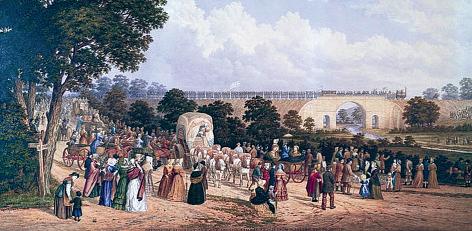

Right: Atotal of 450 people have playedarole in theconstruction of BromfordTunnel,one of the most complexunderground operations of the entireHS2 project. Members of theon-siteteamgathered to watch Tunnel Boring Machine Mar yAnn breakthrough the2.85 metres (9.4 feet) thick concreteheadwall at the western portal of the tunnel at Washwood Heath on May9.Its cutterhead wasadorned with flags by the team on board. HS2

Arrivalofthe tunnel boring machine at Washwood Heath marks completion of the first of the 3.5-mile longtwinbores.
TH Efirst of the 3.5-mile long BromfordTunnel’s twin bores wascompleted on May9,when tunnel boring machine (TBM) Mar yAnn brokethrough at its western end,Washwood Heath in Birmingham.
Named afterthe novelist Mary Ann Evans (more commonly-known by her pen name George Eliot), the TBM waslaunched at the Water
Or tonpor tal siteinJune 2023 onone of the mostcomplex tunnelling operations of the HS2 projec t.
Weighing 1600 tonnes,the 125 metres (410 feet) long machine worked at adepth of up to 40 metres (131 feet) belowground.Its routetook it beneath the Park Hall Nature Reser ve and the M6. Dueto the meandering course of the RiverTame,the tunnel runs
under it four times,aslittle as fivemetres (16.4 feet) below the river bed.The excavation alsohad to avoid disrupting cables carr ying power supplies across the region.
‘Challenging’
“It’sbeen achallenging drivebeneath critical live infrastructureand through complexground conditions,” explained Jules Arlaud, tunnelling directorfor HS2’s construction par tner Balfour Beatty VINCI(BBV ). “I’m incredibly proud of our entireteam,whose exper tise,
dedication and resiliencehas made this possible.”
HS2 Ltdchief executiveMark Wild,who waspresentfor the breakthrough, addedthathe was“immensely proud of the men and women who have worked dayand nighttobring MaryAnn and her crew home safely ”.
MaryAnn advanced by up to 30 metres(over 98 feet) aday,extracting around a million tonnes of spoilduring its mission. This has been processed forreuse in the construction of HS2’snearby Delta Junction.
As well as cutting through the ear th, the TBM put into place20,797 individual concretesegments,each weighing up to seven tonnes, to create the lining rings of the tunnel.The segments were precast at BBV’s plantat Avonmouth.
Thesecond boreisdue to be completed laterthis year by TBM Elizabeth,launched in Marchlast year and named afterDame Elizabeth Cadbur y, who worked to reform education, health and living conditions forwomen and children.
ABRIDGE carrying astretch of the A46 Kenilworth Bypass over the HS2 routewas movedinto placeduring an 18-dayroad closureinApril
The14,500-tonne box structure, which HS2 Ltd
describes as the heaviestof its kind in Europe,was built alongside the road beforebeing pushed into its final position.In preparation forthis,200 metres (219 yards) of the existing road wasremovedand the
area belowitwas excavated. Thebridge move itself,overa distanceof64metres (70 yards), wasacomparatively short partofthe operation, taking 10 hours to achieve using a guiding raft and jacks

Theembankmentwas rebuilt around the bridge and the road reinstated, reopening at midnightonApril 30, some 30 hours ahead of schedule.Alane on either side will remain shut until July 31, while the central
reservation and wingwalls are completed
HS2 Ltdestimatesthattwo years of speed restrictions and lane closures would have been necessaryifamoretraditional approach had been adopted






















Nationalisation in 1948 failed todeliver on itsexpectations, but was hampered by postwar material shortages and theneed to restrain imports, as Mike Jones FRSA FCILT describes.
WITHthe onsetof theSecondWorld War in 1939,the Government instituted a RailwayControlAgreement that placed the‘BigFour’ companies– theLMS, LNER,GWR andSouthern–under Government control. This wasnot full nationalisation, butratherameansofdirecting thecompaniesthrough an executivecommittee made up of industry leadersand Government representatives Agreementwas reachedtoprovide fixedearnings forthe companies, andatrust fund wasestablished to providefuturemoney forpostponed improvement work At theend of thewar in 1945,thiswas worth£148million –equivalenttoaround£5.4billion today. Therewas also an estimated£210million (£7.7billion)for wardamage, butthismoney went largelyunspent duetoshortages of rawmaterials.
As aresult, thecondition of thenetwork deteriorated andin1947anumberofserious accidentsled to 121 passengerfatalities, forwhichthe chiefinspecting officeridentifiedthattrack renewaland maintenance arrearswerethe most significantcause. Industry revenue that year amounted to £355 million(£13.0billion), with
Below: Although steam wasstill seen as the primar ymotivepower in the decade afterthe Second World War, some electrification work was authorised,including the Woodhead Route between Sheffieldand Manchester.A new depot wasbuilt southeast of Manchester at Reddish to look after the locomotives and units used on the route –the depot pictured nearing completion on May4,1954 with EM1 (laterClass 76) No.E26040 (76040).
HAWT HORNE CO LLEC TION
workingexpensesreaching£367million (£13.4 billion), giving an operatingratio of 103% that wasfar abovethe prewar figure.
Nationalisationfollowedin1948, theBig Four companiesbeing paid atotal of £908 million(£27.9billion). This wasfinancedbyGovernmentdebtpaying2.5%, which createdanimmediate annualchargetothe nationalised BritishRailwaysof£27.2 millionannually(£836 million).
An impartialobserverwould conclude that alossmaking enterprise with this amount of debt wasgoing to have to make earlydecisions to reversethe trendin tradingresults to reflectthe liabilitiestransferred to thetaxpayer.
Theday-to-dayrunning of therailwaysreflected the inheritedstructure of theBig Four,creatingLondon Midland, Eastern, Westernand Southern Regions, with Scottish andNorth Easternseparated offastwo additional Regions.
Otherpermutationshad been considered,suchasan eightregionstructure that wouldhaveseparated Wales anddivided theLondonMidland Region into twobased at Euston andManchester, butthese were nottaken forward. Thereasonfor adopting thesplit of theformerLNER


wasthatits organisation hadoperatedadevolved structure, whichmeantthere wouldbelessdisruptionin creating tworegions (Eastern andNorth Eastern, as well as hiving offoperationsinScotland),which wasnot the case with thecentralised approach of theformerLMS.The overallresultwas aconsiderableimbalance in thesize of thenew regions, with theLMR making up 29%oftrain milescomparedto9%for theNER
Steam building continues
Therewas immediatetension betweenthe rolesof theBritish TransportCommission(whichoversaw all nationalised transport), theRailway Executive, andthe Regions–added to whichwas oversightbythe Transport Secretaryand officials.
Therecoveryfromwar hadresultedinthe Government creating an investment programmes committee, where theimpactonrailwas theallocationofsteel forthe production of railsand rollingstock.Inreality,there was asubstantial shortfallinthe delivery of steelcompared to theplan.
As an example, theanticipated introduction of 400new steamlocomotives annually to replaceobsoleteclasses wascut back,withanaverage of 343built between1948 and1953. What wasbuilt showed alackofforesight,with theperpetuationofsteam traction rather than more dieselsand railcars.The policy of theRailway Executive wasdeterminedbyfactors that included theready supply of home-producedsteam coal andthe employmentthat provided,against relyingonimportedoil forwhich scarce fundingwas available.
Onething that alleviated thepotential shortage of locomotiveswas thedecisiontopurchase‘Austerity’ locomotiveswhich,althoughrelativelycheap,were expensivetomaintainand didnot compareinterms of efficiency to theheavy freight2-10-0 ‘9Fs’ builtlater.
Thepre-Nationalisation plan by theLNERtoacquire diesel traction forthe East CoastMainLinewas also dropped. Theprototype dieselsbeing builtfor theLMS andSouthernprogressedwithouturgency,but this did allowthe developmentofthe EnglishElectric2000hp Type 4(laterClass 40).
Thelackofplans foralternativestosteam traction waschallengedbythe BTC’schairmanSir Cyril (later Lord)Hurcomb,who set up theHarrington Committee at theend of 1948 andratherpointedly excluded any representationfromthe RailwayExecutive’s chief mechanical andelectricalengineering (CM&EE)
Above: BR wasobliged to carr yany goods offered to it,and publish its ratesfor doing so,much to the benefit of the rival road hauliers.A pick-up goods is pictured at Ryston, on the Nor folk branch from Downham Market to StokeFerr y, on August 8, 1952 with ‘J17’ No.65549 providing the motivepower.
LA MBERHURST
department.The report took threeyears to complete and concludedthata largescale trialofdieseltractionshould be made on main line services,which wouldinvolve the provisionof100 2000hp single unit locomotives.
This idea wasrejectedbythe RailwayExecutive on thegrounds that theearly dieselsinservice were more expensivetorun than Pacificsteam locomotiveson high mileagerosters,and the335 existing Class7 and eight4-6-2’s were adequate forthe services that mightbe allocatedtodieselworking.Thiswas nota view shared by theBTC,and in time thedecisionwas overturned when a pilotprogramme wasbegun of diesel typeswithdifferent poweroutputranges.
Otherrecommendations made by Harrington that were accepted included an expansionofthe diesel shunting fleetand theuse of diesel railcars on awiderange of secondaryservices. That latter recommendation wasto result in theintroductionofthe DerbyLightweight DMUs in June 1954,ofwhich 217vehicleswerebuilt forservice on theEastern andLondonMidland regions.
So faraselectrification wasconcerned,the Harrington Committeerecommended an early go-ahead forwiring betweenKing’sCross andGrantham, whichdid not actually take placeuntil thelate1980s. Projects that were goingahead were theLNER-sponsoredelectrification of theShenfield suburban line to LiverpoolStreetand the Woodhead Routebetween Sheffieldand Manchester,but theLondon, Tilburyand Southend scheme wascancelled at thedesignstage
Thelackofinnovationand changestoworking practices made it inevitable that operatingcosts wouldhavean upward trendand,althoughrevenue also increased, it was constrainedbyaGovernmentrefusal to increase faresand freightcharges to reflectthe increasedcosts.Asa result, therewas acontinuingdeficit –particularlywhenthe cost of capitalrepresented by debt takenonatthe time of Nationalisationwas addedin. Anet loss of £43.4million (£1.0 billiontoday)was recorded forthe 1948-53period.
Therewas also alimited response to loss-making activities,with thegrowthincar ownershipimpacting localpassenger services,while rail’s obligation as a common carrierfor goodsmeant it hadtopublish itsrates andcarry anytraffic that wasoffered.
Passengerserviceswerewithdrawn over 343route milesbetween 1948 and1950, with afurther 1077 going between1951and 1953 –althoughgoods trafficwas
retained in most cases, whichmeant that complete closurewas limitedto253 miles. Operations in 1953 were conductedover19,598route milesand 51,608 milesoftrack.Littlewas done to consolidatetraffic on duplicateroutes, butwhenmajor rationalisation didtakeplace adecadelater,somelines that did closeweretohavea detrimental effect on future economicconnectivity.
AchangeofGovernmentin October1951saw the Conservativesbackinpower and, although it was decidedthatNationalisation wouldnot be reversed,a return to stronger regional management wasbegun
TheRailway Executivewas abolishedfromOctober 1953,witharevised reportinglinefor chief regional managers (later generalmanagers)supported by area boards direct to theBTC.A decision wasalsomade to return road haulageactivitiestothe privatesector, removing thepreviousintention to integratefreight transportmodes.
TheBTC nowhad itsown boardinthe form of a generalstaff,reflectingthe styleof Army organisation preferredbythe newly-appointed chairman GeneralSir BrianRobertson,who hadbeenchosenasitwas believed thescale of managing 800,000railway employeeswas comparable onlywith theArmed Forces


Above: Thesimple coverofthe 1955 Modernisation Plan repor tbelied the fundamental changes to Britain’s railway system thatwere detailed within.
latertoprovide alower axle weight foruse on lightlylaid tack.For shunting anddepot work,anexisting Hunslet0-6-0STdesignwas chosen
Afterthe war, many of these‘Austerity’ engineswere repatriatedand purchasedbyeitherthe LNER or British Railways.Inall,733 2-8-0s, 25 2-10-0s and750-6-0STs (designated‘J94’ by theLNER) became part of the Nationalised fleet.
Initiallyreturning to theLMS,itwas announcedin mid-1947thatRiddles wouldbecomethe CM&EEatthe RailwayExecutive when it wasformedin1948. He was giventhe unenviable task of producingstandardised designsfor locomotivesand rollingstock,which was achieved by encouragingteamworkamong engineers previously employedbythe constituentcompanies. This ledtoa detailed analysis of thestrengths andweakness of previous practices, with locomotive exchangestaking placebetween regions. As it took some time forstandard designstobeproduced, therewas no alternativebut to continue thepre-Nationalisation building programmes at themajor workshops.
In theory,the BTCwas to set policy on significant operatingand technicalmatters,but in practice thepush fordecentralisation waspredominant.Asan example, a policy initiative in 1955 that airbraking should become a future standard wasrejectedbythe generalmanagerson thegrounds that duplicatefreight services wouldneedto be operated duringa changeover period,a decision that wasmaintaineduntil 1964
Rober tRiddles retires
With theabolition of theRailway Executive, itschief mechanical andelectricalengineerRobertRiddles decidedtoretire. Riddles hadjoinedthe railwayas apremium apprenticeatCrewe worksin 1909 and progressed throughappointmentsatthe LNWR andLMS, butthe arrivalofWAStanier as theLMS chief mechanical engineer in 1932 sawRiddles appointedasassistant to the CMEtopromote thenew design ideasbeing implemented.
At thestart of theSecondWorld War, Riddleswas appointedasa director at theMinistryof Supply,where aneedfor newheavy freightlocomotives foruse in countriesabroadwas identified.Initially,the LMS‘8F’was deemed most suitable,but asimplifiedlocomotivewas to follow that became the‘WD’2-8-0.Inall,935 of thesewere builtbetween 1943-45, with a2-10-0 versionintroduced
Below: Rober tRiddles wasBritish Railways’ first chief mechanical and electric engineer, but he is pictured in retirementat Bridgnor th, Severn ValleyRailway,on May20, 1978 fora rededication ceremony forpreser vedClass 7 No.70000 Britannia, which had been the first standardlocomotiveto enterser vicewith BR in Januar y1951. DB EECH
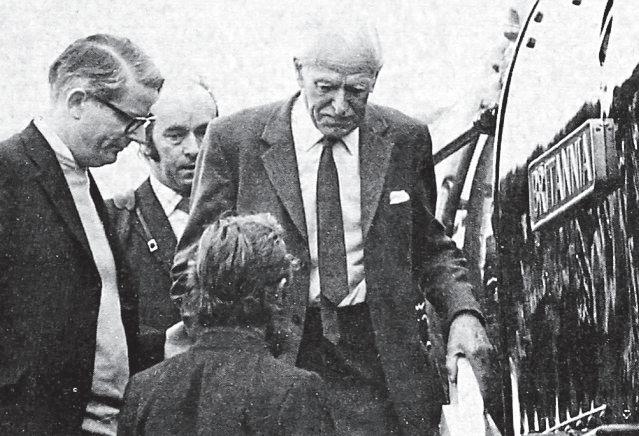
With thedemise of theRailway Executiveand retirement of Robert Riddles, Roland Bond wasappointed as chiefmechanicalengineeraspartofthe central staffretainedbythe BritishTransport Commission.An unhappyrelationshipwiththe regionsfollowed, but Bond wasaforthrightindividualand setout that the instructions he wasempowered to give wouldbeobeyed and, if not, he wouldinsistoneffective remedial action. Hisresponsibilitiesincludedstandards to be observed in themanufacture andmaintenance of locomotives androlling stock, preparationofanannualbuilding programme, allocation of work to thevarious workshops, andarange of significantadministrativeduties.
Thestandardclasses begantoemergeafter 1951.A template hadbeenestablished,but drawingoffices were allowedtointerpret thesefor workshop construction. Unlike theClass 7‘Britannias’, whichwereaninnovative design basedonahigh-powered,two-cylinder locomotive,manyofthe classeswereupdated versions of previous designs.
In fact, no fewerthanfour4-6-2 designswereinitially proposed on thebasis that this wheelarrangement alloweda widerfirebox with optionsfor adifferent axle load.Inthe event, only the‘Britannias’werebuilt in a significantnumber(Nos. 70000-70054), plus oneClass 8 No.71000 and10Class 6‘Clans’ (Nos.72000-72009, reducedfromthe 30 that were intended). A4-6-2Class 5 scheme wasdropped,substituted by a4-6-0 design that retained the6ft 2indriving wheels,ofwhich 172werebuilt (Nos.73000–73171).
Four design officeswereusedatBrighton, Derby, Doncasterand Swindon, with construction at these locationsaswellasCrewe,Darlington, andHorwich Standardised partsweretobeused, with ahighrunning platetoenablemovingparts to be easily accessed,plusa wide-angledvalance that allowedpistons to be withdrawn. Cabsides were also notextendedbelow footplatelevel, againtoallow maintenanceaccess.
Forheavy freightworking,the firstideawas a2-8-2 with 5ftdiameterwheelsthathad aresemblance to the ‘Britannia’design, butthe design wasreworkedasa 2-10-0 becauseofconcernsabout adhesion.Brightondesign office wastaskedwiththe detailed design,and succeeded in placinga wide fireboxoveracoupled drivingwheel
Thefinal result –Class 9F –gaveanability to produce closeto40,000lb of tractive effort,23% more than a ‘Britannia’, andultimately251 were built. This included BR’s last steamlocotobebuilt,No. 92220atSwindon Worksin1960, whichwas outshopped as EveningStarin expresspassenger trainlivery.
Thewas somethingofaheadstart forcoachingstock,

as acommissionhad been establishedbythe Railway CompaniesAssociation to addressissuesabout intercompanyworking that hademerged during thewar.Itled to theadoptionofthe C1 body outlinethathad been used by Bulleidonthe Southern,withbodylengthstandardised at 63ft 6inand bogiecentres at 46ft 6in. Ashorter standard length wasadopted forsuburbancoaches.
Thefirst prototypes of what wastobecomethe Mk.1 standard coachdesignwereexhibitedatMarylebone in September1950, with thefirst production series followinginMarch 1951.Crashworthiness of theend load wasimprovedto200 tons to reduce theinstances of telescopingwhich,combinedwiththe useof buckeyecouplings, greatlyreduced fatalities when collisions occurred.
Themostsignificant eventof theperiodwas the publicationbythe BTCinJanuary 1955 of the ModernisationPlan. Thereweremisgivingsin Government circles, butParliamentapprovedthe plan andthe BTCestablished 16 specialist panels to develop programmes such as electrificationand marshallingyard projects.Later in 1956,a regularchairman’sconferenceon modernisationwas instituted to establisha tightergripon planningand execution.
Proposalsweretobeimplemented over 15 yearsata cost of £1200million (£27billion in currentday value),but within twoyearsthe cost hadinflatedto£1600 million (£33billion), butnet revenuewas forecast to improveasa result by £85million perannum (£1.9 billion).Investment reacheda peak in 1959 with £168 million(£3.3 billion) spent.
What wasnot said at thetimewas that internal calculations suggesteduptoa thirdofthe improved financialresultwould come from removing uneconomic
Above: 9F Class No 92220 Evening Star famously became the last main line steam locomotivetobebuilt by BR, the locobeing pictured at Swindon Works prior to its naming on March18, 1960 and officially entering ser viceaweek later. The‘9F’ would be in traffic forjust five years,afraction of its ser viceable lifetime.
services.Littlethought wasalsogiven to theeffectof the£400million (£8.25 billion) road improvementplan, includingthe firstmotorways,thatwas also approved in 1955
Acoreelement of theplanwas theprogressive replacementofsteam locomotivesbyelectricand diesel traction;the replacementofloco-hauled coachesby DMUs;and,where coacheswereretained, an improved design to providebetterriding.
Freightwagonsweretobefittedwithcontinuous braking, andoperationsweretobemademoreefficient by building largemarshalling yards. Investment in trackto allowhigherspeedsontrunk routes andthe replacement of mechanical signalling were also features of theplan.
Electrificationfinally resumed, with 550route miles beinginstalled from 1959-62, whichincludedextending theSouthernRegionthird-railsystemtoserve theKent coastplusbuildingoverheadwiringfor theLTS route, theNorth East London linesout of LiverpoolStreet, and theGlasgow suburban area.Astart wasmadeonWest CoastMainLineelectrification with wiring from Creweto Manchester andLiverpool,althoughthe East CoastMain Line proposal wasonceagain shelved.
Therewas no common ground when it wasdecided to implementapilot programmetoevaluatefuturediesel traction,withthe WesternRegionoptingfor mechanical (hydraulic)ratherthe electric transmission.There were good reasonsfor thedecisionatthe time,inthat workshop experience at Swindonwas more suited to that form of drive, andwhich proved to have better availability than theearly diesel-electrics of similarpower
Bond acknowledged that therehad been little follow-up of theinitial diesel locos, although they didprovide experience to writethe specifications forthe pilot programme. Astartingpoint wasthatthe complete range of trafficshouldbecovered,which resulted in threepower groups between800 and2000hp, whilethe maximum

axle load wasspecified at 20 tons on accountofsmaller diameter wheels (ratherthanthe 22.5 tons allowedfor larger diameter coupledwheelsusedbysteam locos)
Thepilot programmecovered 174locomotives with sevenmakes of engine,eight transmission variants,and sevenbuilders. Delivery wasrequiredwithin twoyears Theplanwas that athree-year period of evaluation would follow before fleetorders were placed.The result would be that thefleet of 18,000 steamlocos wouldbereduced to 7000 by 1970.Constructionwould continue of 359new Standard typesthatremainedout of orders for999,aswell as developmentworktoimprove thefleet as awhole
Theplanwas soon to change,however,asthe BTC believed thepacewas tooslow. Thesuccess andfailure of thepilot programmetypes hadbecomeimmediately evident, so fleetordersbegan to be placed more quickly andinlarge quantities
At thetimethe ModernisationPlanwas published, there were 1,141,500freight wagons in operationand 297,000new vehicles were to be constructed, allowing 686,500obsolete typestobewithdrawn.The 1974 position wasexpected to be afleet of 752,000–including 140,000coveredmerchandiseand 9000 cattle wagons. Lookingahead,the scaleofoperating this fleetled to theconclusionthatefficient marshallingmustbea priority forthe future.Thiswas to be achieved by building largeyards to eliminatesmaller,older sitesthathad involved endlesstripping of wagons before beingformed into long-distancemovements.
Therewas little trafficforecasting to supportwhatwas proposed,and even less thinking aheadabout reducing wagonloadinfavouroftrainload operation. Although therewas strong economic growth averaging3%per year by 1962,merchandise trafficfellby27%. Passengerrevenue faredlittlebetter, fallingby17% by 1974
Above: The Modernisation plan forfreightincluded building aseries of large strategic marshalling yardstoimprove efficienc y, this one at HealeyMills (west of Wakefield) opened in 1963 but lostmost of its traffic in the 1980s and closed completely in 2012 –although par t fo the siteiscurrently being reopened as par t of the TransPennine RouteUpgrade programme
Theexpectation wasthatthe investment would improverevenue by providinghigherstandards of service, particularly forfreight whichremainedfocused on wagonloadmovements.There were dissenting voices that thefuturewould lieintrainload working, especially foroil trains,but theseviews were discounted
At thestart of Modernisationin1955, therailway deficit was£38.2 million. Butdespite very significantinvestment, this figure hadrisen to £159.0 millionby1962. At current dayvalues, this is an increase from £851 millionto£2.9 billion. Theplanhad failed as,althoughequipment was renewed, operatingproceduresgenerally didnot change andthere wasafailure to keep up with market demands.
It hadbeenevident as theplanprogressedthatall was notwell, andthe Government instituted areviewin1959 precipitated by fallingpassenger andfreight revenue. A significantchangetookplace with theappointment of Ernest MarplesasMinisterofTransport,togetherwith newseniorofficials in thedepartmentwho believed that asmaller,morecost-effectiverailway wasthe future direction.
Railwaypay hada bigimpactonthe financialresults, andadecisionbyanindependent tribunal to awardan 8% payincreaseinvalidated theforecastfinancial results identified in the1959review. At this point, Modernisation spending planswerealsocurtailed untilgreater clarity aboutthe size of thenetwork wasavailable,and an advisory groupofleading industrialists wasformedto advise Marples.
Thechairmanwas SirIvanStedeford,headofTube Investments, with members that included Dr Richard Beeching from ICI. Theoutcome of advice from the Stedeford Advisory Groupwas that theBTC should be abolishedand anew BritishRailwaysBoard established, whichwas putintoeffectbythe 1962 TransportAct and implemented on January1,1963.
Dr Beeching wasappointed chairman ■